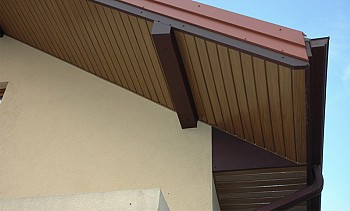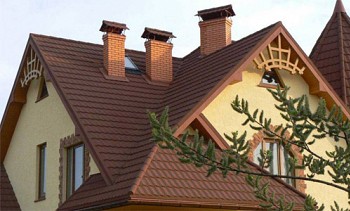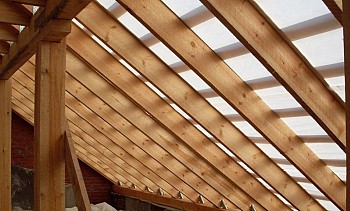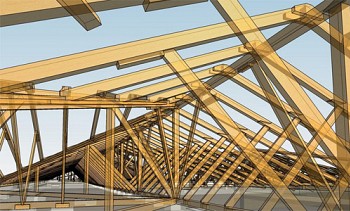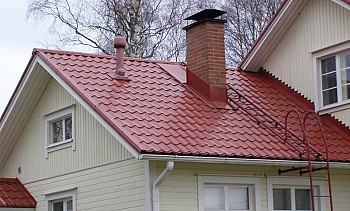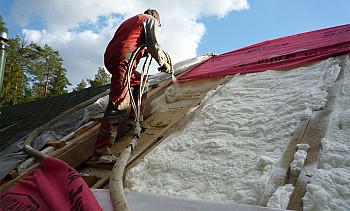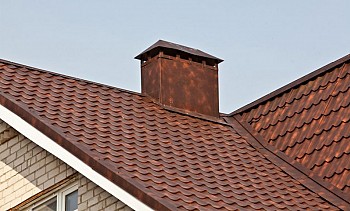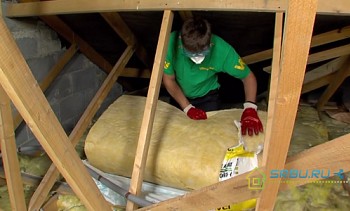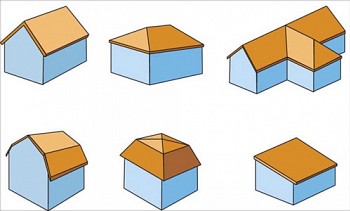Roof slope for various conditions and roofing materials
The roof of the house can have a different shape, as well as a different slope of the roof. Moreover, the angle of the roof slope is most often due not to aesthetic considerations, but to the practical side and certain requirements. Indeed, on how sharp or flat the roof is, its strength and proper functioning depend. Therefore, the slope is calculated taking into account all the necessary parameters.
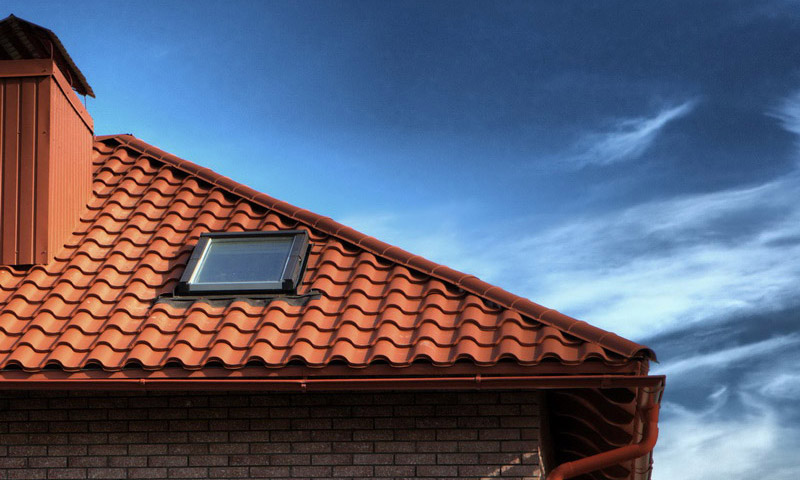
Content:
Three main factors affecting the roof slope
Builders have taken this value (the angle at which the roof slope is relative to the horizon) to measure in degrees or percent. To obtain an accurate result, use a geodetic tool. To be clear, 0 degrees corresponds to a completely flat roof, and large values of the angle correspond to an acute-angled roof. For pitched roofs, it usually ranges from 11 0 up to 45 0. During construction, it is necessary to calculate what this angle should be. And for this you need to pay attention to the following things.
Wind load
If strong winds prevail in your area, then you should not think about a project with a sharp roof. Due to the high windage of the roof with a large slope, it is more susceptible to the damaging effects of wind. In this case, it is better to make the roof more gentle (the smaller the slope of the ramp, the safer), and the rafters under it to build a strong, reinforced type. Although the construction will cost much more, the roof will be much better protected from the wind. However, when building the roof of a house, one should take into account not only the strength of the wind, but also its direction. So, for a metal tile, it is desirable that the wind blow directly into the plane of the sheets. If its impulses come from the ends, then the sheets of the roof will be more likely to bend and come off. Therefore, depending on the prevailing wind direction, it is necessary to rotate the roof slopes accordingly.
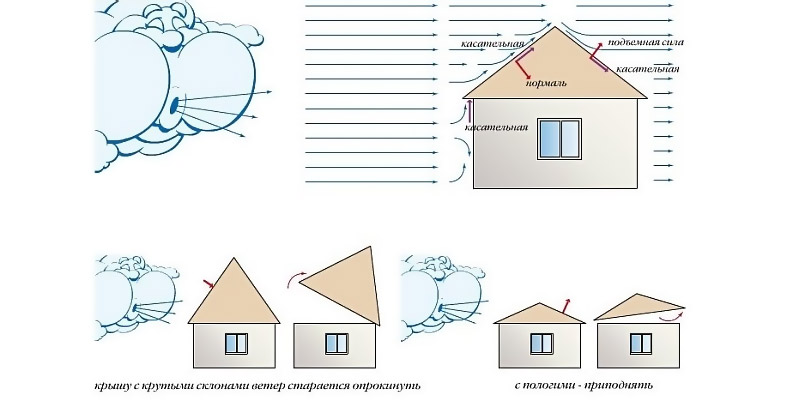
Rainfall and snow loads
If you live in such a climate where snow cover in winter is quite solid, then the roof is made with a minimum slope of the roof of 45 degrees (more can be, but not less). This is necessary to slide the snow down, otherwise it cakes on the roof, forming too large a layer that can push through the coating. But if the roof has a sufficient angle (about 45 degrees), you can not worry about strengthening the rafters. As, however, about the snow retention system. However, wind loads for such a roof are amplified. Therefore, the final choice is made, given all climatic conditions.
It should be noted that not only snow, but also rain, hail, and scorching sunlight will periodically test your roof for strength. If the terrain is sunny and there is little rain in the year, then you can limit yourself to a flat roof with a slope close to a minimum.
Important: in spite of the fact that the flat roof is called exactly flat, the slope is still necessary. The minimum slope for a flat roof is 1 degree or 1.7%.
Roofing material
The material with which the roofs are covered can be smooth or rough. In the latter case, water will drain from the roof worse, lingering on its surface (like snow). But with a smooth coating, all moisture drains instantly. There are other design parameters on which the minimum and maximum slope depends.
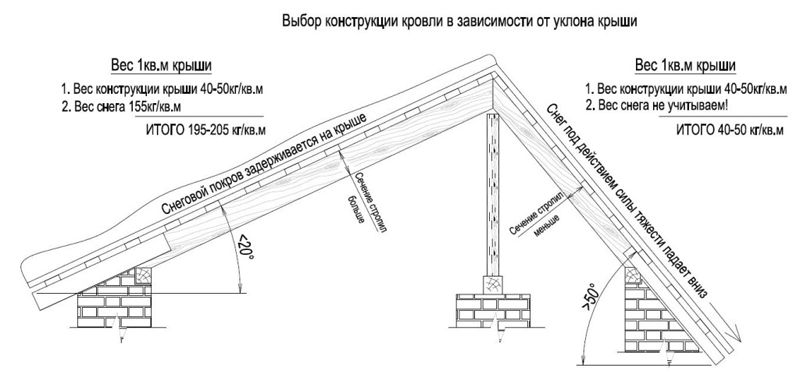
Minimum roof pitch for various materials
Metal tile
The smallest angle of inclination of the slopes of the roof made of metal is 15 degrees (according to some manufacturers of metal - 14 degrees).With small deviations, some manufacturers recommend lubricating each joint of sheets with a sealed and waterproof, frost-resistant composition. However, it was experimentally found that most of all the snow loves to lie on metal roofs with a slope of 20 to 35 degrees. Too small a slope is also bad - the water does not have time to drain from the roof, pressing on the roof and leaking at the joints when the rains are too heavy. Only the choice of tiles with an increased wave height will somewhat correct the situation.
Professional sheet (professional flooring)
Well, the minimum slope of the roof from the profiled sheet has a slightly lower value - 12 degrees. Small tilt angles require a two-wave overlap, and angles from 15 degrees require an overlap of 20 centimeters. The step of the crate increases with increasing slope. For almost flat roofs, a continuous crate is made, because when a large amount of snow accumulates, roof deflection can occur.
Flexible tile (soft roof)
Flexible tile lathing is a solid base made from sheets of plywood or OSB. The minimum allowable slope of the slopes for this roofing is at least 11 degrees.
Bitumen based materials
For such soft coatings, the minimum is nothing at all - about two degrees. A very small angle of inclination requires an increase in the number of layers of the roof (because good moisture protection is extremely important for flat roofs). If we provide only 1 or 2 layers of coating, you will have to make a slope of the ramp at least 15 degrees.
Euroslate (Ondulin)
For this material, the minimum slope of the pitched roof is small, it is 11 degrees. But when working with ondulin on roofs with a slight slope, there is one condition: you need a solid crate.
Clay tiles and asbestos-cement slate
For these roofing materials, a slope of 22 degrees is required. At the same time, one must carefully consider the calculation of the rafter system, since the loads from heavy material will be considerable. And if you add a layer of snow to them or powerful gusts of wind, then we will get increased requirements for the roof support system. And it should also be noted that a decrease in the slope entails an increase in the loads on the rafters.
How to calculate the roof slope: a few recommendations
Now consider how to calculate the angle of the roof. To begin with, the slope, as noted above, can be measured in degrees and percent. Sometimes inexperienced developers confuse them, which leads to errors in the calculations. But these values are by no means equal. However, being attentive and using special tables, you can make a quick translation of quantities.
The ratio of degrees and percent in the slope of the roof
| Degrees 0 | Interest% | Degrees 0 | Interest% | Degrees 0 | Interest% |
|---|---|---|---|---|---|
| 1 | 1,7 | 16 | 28,7 | 31 | 60,0 |
| 2 | 3,5 | 17 | 30,5 | 32 | 62,4 |
| 3 | 5,2 | 18 | 32,5 | 33 | 64,9 |
| 4 | 7,0 | 19 | 34,4 | 34 | 67,4 |
| 5 | 8,7 | 20 | 36,4 | 35 | 70,0 |
| 6 | 10,5 | 21 | 38,4 | 36 | 72,6 |
| 7 | 12,3 | 22 | 40,4 | 37 | 75,4 |
| 8 | 14,1 | 23 | 42,4 | 38 | 78,9 |
| 9 | 15,8 | 24 | 44,5 | 39 | 80,9 |
| 10 | 17,6 | 25 | 46,6 | 40 | 83,9 |
| 11 | 19,3 | 26 | 48,7 | 41 | 86,0 |
| 12 | 21,1 | 27 | 50,9 | 42 | 90,0 |
| 13 | 23,0 | 28 | 53,1 | 43 | 93,0 |
| 14 | 24,9 | 29 | 55,4 | 44 | 96,5 |
| 15 | 26,8 | 30 | 57,7 | 45 | 100 |
#1. The slope, measured in degrees, is the real angle between the floor and the rafter. It can be calculated by dividing the height of the ridge (above the floor plane) by half the width of the roof. If the roof has a broken shape, then the part of the width of the house located under this section of the roof is taken. For example, the house has a simple roof 10 meters wide. The skate has a height of 2 meters. We make calculations. Divide 2 by 5, getting 0.4. It’s easy to translate into percentages: multiply the number by 100. 40 percent will come out.
#2. You can go an even simpler way. Going online, find an online service with a calculator for calculating the roof slope (there are plenty of them on the Web). Enter the necessary values. This is the width of the building and the height of the ridge. In parallel with you, the length of the rafters will be instantly calculated. The principle of operation of such calculators is based on the fact that, in fact, all roofs consist of gable roofs, which are calculated as a regular triangle.
#3. And another way - it is suitable for those who believe their hands and eyes more than calculations. You just need to take and measure the slope, using a simple device - an inclinometer (otherwise, an angle meter). Today, there are many versions of this device, both analog and digital.
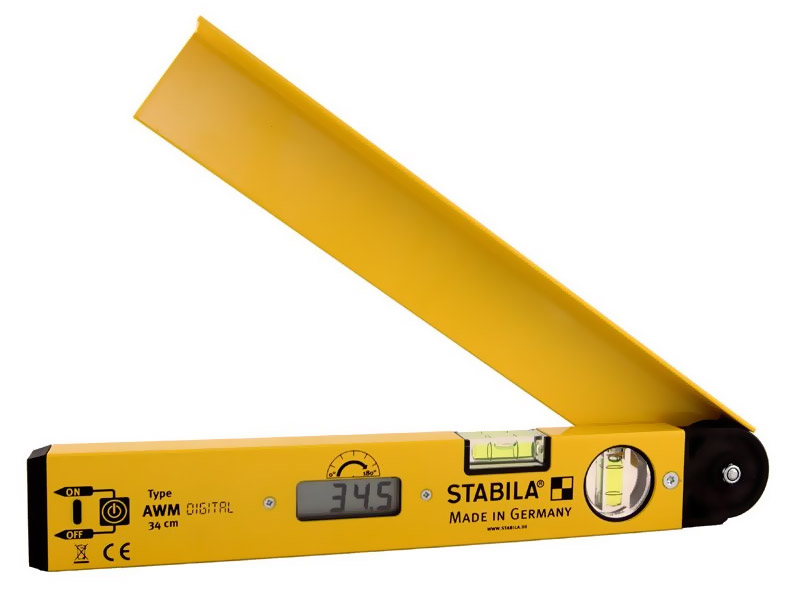
An electronic goniometer with which you can measure the angle of inclination of the roof slope.
#4. Since the width of the house cannot be changed in any way, it is possible to vary the slope of the roof plane by changing the height of the ridge. Naturally, only when the walls of the house and its foundation are reliable, and their strength has a margin. After choosing the optimal slope for himself, the developer can determine what height he needs a skate. To help him, there are special tables with coefficients by which one second should be multiplied from the width of the overlap (the slope is set).
#5. In practice, the height of the ridge can be determined quite simply. We take and mark the two external walls of the house (our ramp will be located along them). We rub the cord with chalk and pull it tight between these marks. We measure the center of the cord, and at this point we set the bar. It should be strictly perpendicular to the plane of the overlap (for accuracy, we will check this using a square).
Changing the position of the twine relative to the bar (moving it up), we try to achieve the slope we need. To do this, periodically check the angle from the wall. Once the desired result is achieved, put a mark on the bar. After sawing off this piece, we make a template for the supports of the ridge. If supports are not needed, then at each of the ends of the roof we determine the height of the joint of the two rafters, fixing the rails with a stretched cord.

